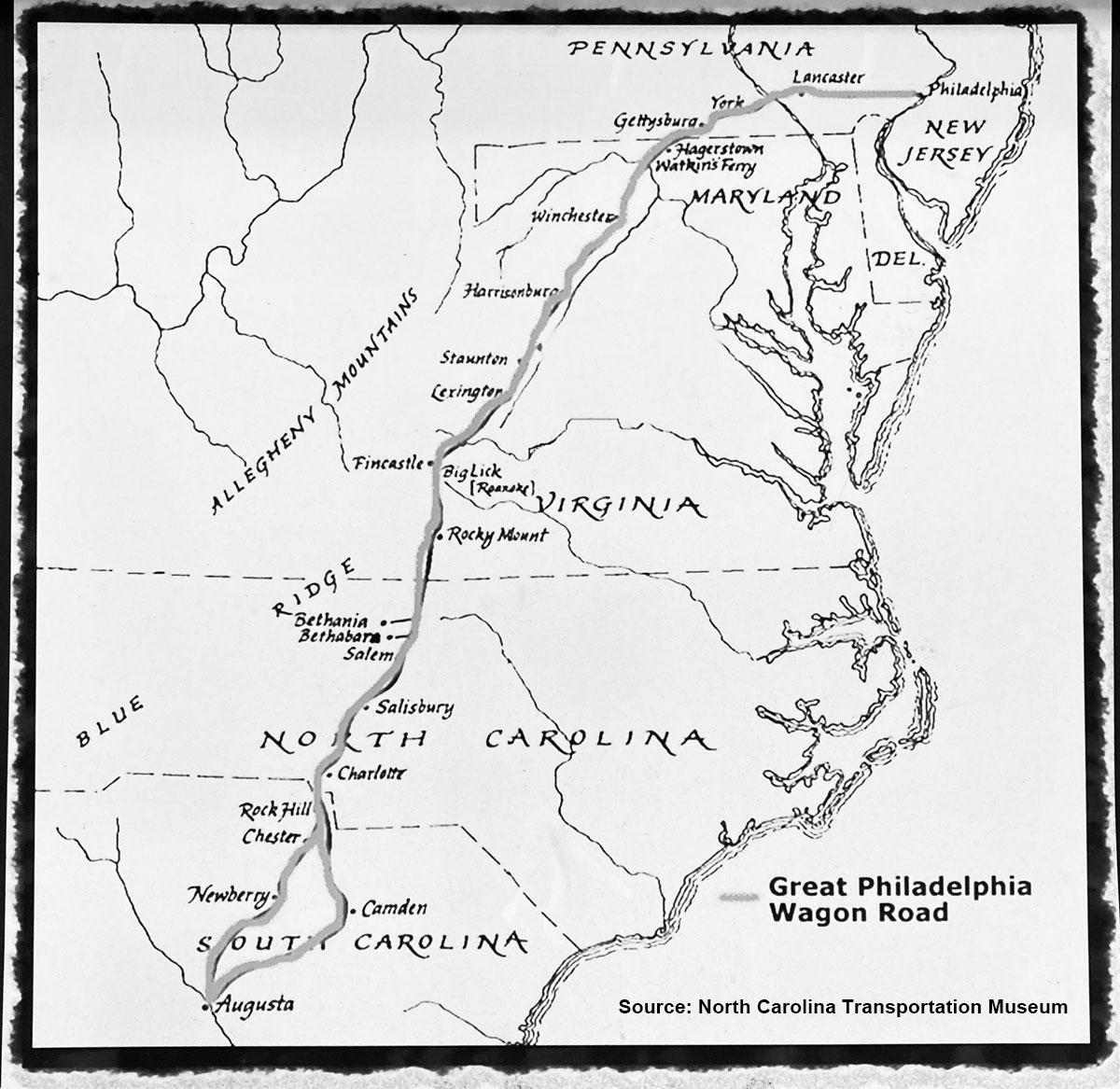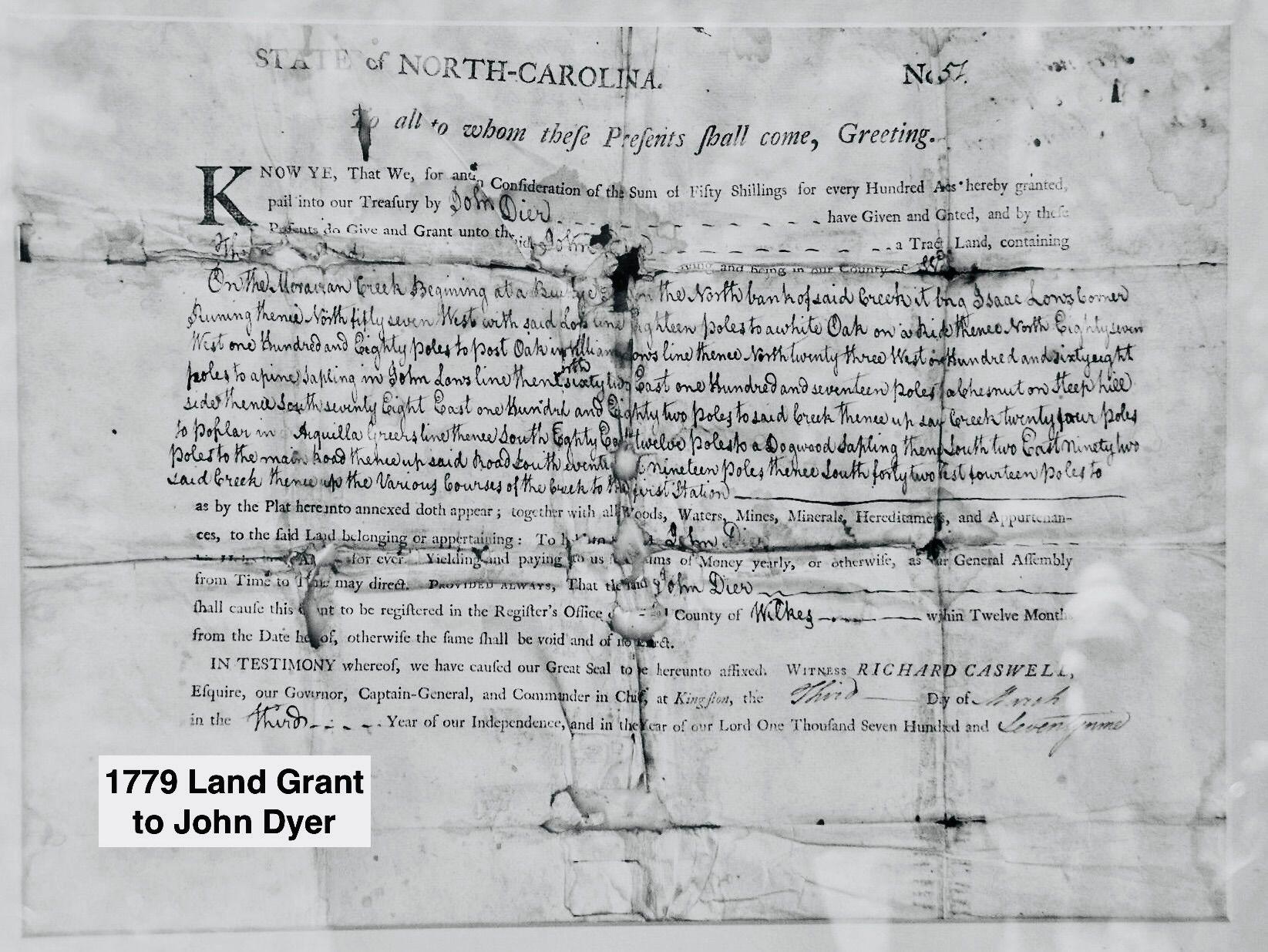 In the mid-1700s, European colonists, many arriving from ships in or near Philadelphia, began traveling south along “The Great Wagon Road” in search of land for new homes. Many colonial families settled in and around the Yadkin River valley and along the eastern foothills of the Blue Ridge Mountains of North Carolina. The vast forest, open meadows and fertile river valleys were inhabited by buffalo, elk, mountain lions, bears and wolves. It was a wild frontier to the pioneers and an ancient homeland to the Catawba and Cherokee Indians. These early settlers were farmers when agriculture was characterized by ox power, wooden plows and seeds sown by hand. Crops were cultivated with a hoe and harvested with a sickle. It was a hard life, enabled by the protestant work ethic, the assistance of neighbors and the motivation to accumulate wealth. The colonial farmers prospered, formed communities and promoted commerce. Our agrarian heritage was established, and it dominated society for over two centuries.
In the mid-1700s, European colonists, many arriving from ships in or near Philadelphia, began traveling south along “The Great Wagon Road” in search of land for new homes. Many colonial families settled in and around the Yadkin River valley and along the eastern foothills of the Blue Ridge Mountains of North Carolina. The vast forest, open meadows and fertile river valleys were inhabited by buffalo, elk, mountain lions, bears and wolves. It was a wild frontier to the pioneers and an ancient homeland to the Catawba and Cherokee Indians. These early settlers were farmers when agriculture was characterized by ox power, wooden plows and seeds sown by hand. Crops were cultivated with a hoe and harvested with a sickle. It was a hard life, enabled by the protestant work ethic, the assistance of neighbors and the motivation to accumulate wealth. The colonial farmers prospered, formed communities and promoted commerce. Our agrarian heritage was established, and it dominated society for over two centuries.
In 1778, John Dyer (aka Dier) and his family settled on land in Wilkes County along the Burke Road, approximately one and a half miles from the Forks in the Road community (called Moravian Falls since 1874). Virgin forest timber was plentiful. Tapping into these abundant resources, he built, probably in conjunction with local artisans, a distinctive log home. Included were building materials that he purchased; weatherboard, glass, and hardware. The sunken roadbed of the old Burke Road, once an important route between Wilkesboro and Morganton, remains in front of the house and extends eastward.
In 1779, Dyer received a land grant (318 acres) for the property that included his homestead (what is now the Foothills Heritage Farm). During this time, the American Revolutionary War (1775-1783) was raging, The Declaration of Independence was signed just 3 years earlier, and North Carolina was one of only 13 states.
This property came into the Hubbard family when Benjamin Hubbard purchased this piece of land from a relative of his wife, Rosannah Dyer Hubbard, in 1784. The original 318 acres grew to almost 1,000 before parcels were sold off. It remained in the Hubbard family until it was donated to the Foothills Heritage Farm, Inc., which is working to preserve and restore the surviving 25 acres. The Hubbard family has the original land grant document.
Grant Transcript:
STATE OF NORTH CAROLINA No. 51
To all whom these Presents shall come Greetings
Know ye. That we, for all consideration of the Sum of Fifty shillings for every hundred acres hereby Granted, paid into our Treasury by John Dier a tract of Land, containing Three Hundred Acres lying and being within our County of Wilkes.
 On the Moravian Creek beginning at a Buckeye on the North bank of said Creek being Isaac Laws corner Running thence West with fifty-seven West with said Laws line one Hundred Eighty Poles to a white Oak on a ridge thence North eighty seven West one Hundred Eighty poles to a post Oak in William Laws line thence North twenty three West one Hundred and sixty eight poles to a pine sapling in John Laws line thence North sixty two West and East one Hundred Eighty two poles to said Creek then up said Creek twenty four poles to a poplar in Aquilla Greers line thence South eighty East twelve poles to a Dogwood sapling thence South two East ninety poles to the main road thence twenty nineteen poles thence South forty two West fourteen poles to said Creek and up various courses of the Creek to the first Station as to the Plat hereunto annexed doth appear together with all Woods, Waters, Minerals, Hereditaments and Appurtenances, to the said Land belonging or appertaining to John Dier to H forever. Yielding and paying to us some sums of money yearly, or otherwise, as our General Assembly from Time to Time direct. PROVIDES ALWAYS, that said John Dier shall cause this Grant to be registered to the Register’s office in said County of Wilkes within Twelve Months from the Date hereof, otherwise the same shall be void and of no effect.
On the Moravian Creek beginning at a Buckeye on the North bank of said Creek being Isaac Laws corner Running thence West with fifty-seven West with said Laws line one Hundred Eighty Poles to a white Oak on a ridge thence North eighty seven West one Hundred Eighty poles to a post Oak in William Laws line thence North twenty three West one Hundred and sixty eight poles to a pine sapling in John Laws line thence North sixty two West and East one Hundred Eighty two poles to said Creek then up said Creek twenty four poles to a poplar in Aquilla Greers line thence South eighty East twelve poles to a Dogwood sapling thence South two East ninety poles to the main road thence twenty nineteen poles thence South forty two West fourteen poles to said Creek and up various courses of the Creek to the first Station as to the Plat hereunto annexed doth appear together with all Woods, Waters, Minerals, Hereditaments and Appurtenances, to the said Land belonging or appertaining to John Dier to H forever. Yielding and paying to us some sums of money yearly, or otherwise, as our General Assembly from Time to Time direct. PROVIDES ALWAYS, that said John Dier shall cause this Grant to be registered to the Register’s office in said County of Wilkes within Twelve Months from the Date hereof, otherwise the same shall be void and of no effect.
IN TESTIMONY whereof, we have caused our Great Seal to be affixed Witness Richard Caswell, Esquire, our, and Governor, our Captain General, and our Commander in Chief at Kingston, the third day of March, in the third year of our Independence, and in the Year of our Lord One Thousand Seven Hundred and Seventynine.
The Within grant registered in the Register’s Office, Book A, Page 49
By John Brown State of North Carolina Wilkes County
December Term 1779
The within grant is duly registered with the said Court and ordered to be registered.
Wm Lenoir, Cle
